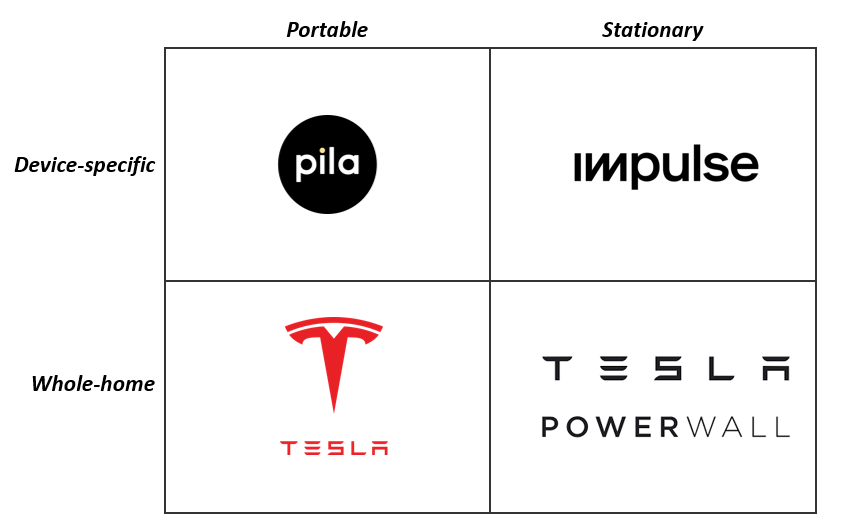Everything is batteries now
And why that matters for you
They’re in your home, they’re in your car, they’re quietly taking over.
I am of course talking about batteries.
Because of the dramatic fall in lithium-ion battery prices over the last 10 years, they are starting to show up in all sorts of unexpected places, and this has important implications for how the future energy system will work.
Today, I’ll briefly outline the 4 places batteries are being integrated into the home, and try to reason through how this could continue to evolve.
But first, why is this happening?
First, people really don’t like losing power or the use of their appliances. As homes get more electrified, there is increasing desire for outage protection or other forms of backup power so that a wind storm doesn’t knock them back to the 1800’s.
Second, there is an increasing economic incentive to shift power usage throughout the day. Since the grid is built for the peak, many utilities have implemented steep Time of Use rates to disincentivize power use during peak evening periods. Traditionally, homeowners have 'solved' this problem by e.g. turning off their A/C or using their dryer at other times, an inconvenience.
But now, batteries give homeowners more options to manage their bill without changing their lifestyle. This is generally a side-benefit, with systems ‘oversized’ for performance and backup power reasons, but an increasingly important one.
The upshot is that we should expect increasing proliferation of batteries in the home across 4 distinct points.
1) In-line backup power (e.g., Pila)
Ever worried about the food in your fridge rotting during a power outage? Buy a battery from Pila Energy and worry no more.
These batteries are designed to sit in between your home wiring and key loads (e.g., a refrigerator) providing device-leve backup power in case of an outage.
But, at a cost of ~$1,299 per 1.6 kWh unit, or ~$800 per kWh of capacity, these batteries have the potential to be cycled more frequently to offset peak evening use. Assuming a full-size fridge draws ~100 W per hour of use, cycling this daily during a peak periods (and charging during off-peak periods) would save a homeowner ~$30 per year1 or ~$300 over a ten-year appliance life.
The big benefit though is the ease of set-up. No installation or home rewiring required for backup power of key devices. The bill management is just gravy.
2) In-device backup power (e.g., Impulse, Copper)
Boil water in second? Check.
Complete daring feats of culinary wizardry like frying eggs with no oil or tempering chocolate without burning? Check.
Continue to work in a power outage? Check.
The cooktop from Impulse Labs is the leading example of our next type of battery: those built into devices themselves.
While this is foremost for performance reasons (few household 240V circuits can deliver the 10kW of power needed to boil water that fast), these batteries also provide backup power in the even of an outage and, you guessed it, the ability to avoid energy charges during peak hours if so configured.
Assuming one uses ~1 kWh while cooking each evening, the savings come to ~$75 over the course of the year, or ~$750 over a ten year appliance life2.
The main benefit here is the brilliant cooking itself, with the backup power and bill management potential happy parallel benefits.
A brief interlude on home wiring and the fire code
In European countries like Germany, homeowners are allowed to install up to ~800 W worth of solar panels on their balconies or other outdoor space without wiring changes. The panels include AC microinverters and just plug back into the normal home wiring.
This is not allowed by the National Electrical Code (NEC) in the US, though there has been some effort to allow this in some parts of the US (e.g., Utah).
As a result, the in-line and in-device batteries like those from Pila and Impulse are limited to off-setting the specific loads they're connected to. If this were to change, and they could feed power back into the house to offset other loads, the opportunity for and value of these types of batteries could be significantly higher.
3) Whole-home battery storage (e.g., Tesla Powerwall)
The next category is what most people think of when they think of home energy storage: stationary batteries that connect through a home's electrical panel to support household loads.
There are different specific system architectures—which may involve a 'smart' electric panel or not, paired solar panels or not—but in general these batteries are designed and sized to handle loads across a household through existing wiring.
These systems tend to be larger-still than device-specific batteries, in the ~5-15 kWh range3, so that they can provide 1-3 days of outage protection if necessary. Given this capacity, these batteries provide another powerful way to manage a home's energy use around peak periods.
While the cost per kWh is often lower (in the ~$500-1,000 range4), these systems are more expensive in absolute terms because of their size and their need for professional installation by a skilled installer5.
Assuming one uses ~3 kWh during each evening peak, the savings come to ~$220 over the course of the year, or ~$2,200 over a ten year battery life6.
This value will vary more than in the previous cases because most systems like this are: 1) paired with solar panels, meaning their charging cost is lower; 2) set up to feed power back onto the grid. The value then will depend on the specific system architecture and the programs a given utility or electricity provider may have in place.
4) EV bi-directional charging (e.g., Tesla Cybertruck)
The final category of battery also sits in one's garage, only on wheels. EV batteries are the biggest of the bunch, ranging from ~57 kWh for a base Tesla Model 3 to ~212 kWh (!) for a Hummer EV, as I've written about before.
Unfortunately, right now only a few models (e.g., the F150 Lightning, the Tesla Cybertruck) are equipped for bi-directional charging (when equipped with the right house-side equipment). This gap exists for a host of reasons, including uncertainty that should be resolved in the 2026 National Electric Code, but I fully expect wider deployment of these features going forward.
As with the other batteries, to-date these systems have been marketed for outage protection but can provide the appropriate bill management if configured correctly, with similar value at stake as the whole-home example above.
The EVSE path has a couple of big benefits: 1) people are buying EVs anyway, this bill management is gravy; 2) manufacturability of cars creates more space for learning curves / less to install with custom local labor.
The value created should more than pay for the incremental cost of the equipment with these capabilities, with the absolute size of the batteries creating large resources for grid support or other value-added services.
So who's going to win?
I think there's a role for all of these, and they are not mutually exclusive. One might have a whole home backup through a Tesla Powerwall and still want the high power of an Impulse stove, or use their F-150 Lightning for bill management but still want their Pila battery to ensure backup power for their fridge.
That said, for pure scale of impact I would bet on the devices that have benefits beyond backup power (e.g., Impulse, EVs) and provide peak shaving as the cherry on top. These will get more traction, faster, from customers less focused on the pure economic benefits, while leaving the door open for big benefits down the road.
The impact is already being felt, with individual customers getting better stoves, faster cars, and more resilient home electricity. In the future, these batteries will come together to have a meaningful impact on the grid as well.
I've focused primarily on hardware architectures today, as much to clarify the archetypes for myself. In a future post I hope to dig further on the business models and software that are driving these systems, and where the incremental opportunities could be.
~100 W for 4 hours of peak equates to cycling ~0.4 kWh per day. A $0.20 spread between off-peak and peak kWh rates creates a value of $0.08 per night, or ~$30 per year.
~2,000 W for 0.5 hours of peak equates to ~1 kWh per day. A $0.20 spread between off-peak and peak kWh rates creates a value of $0.20 per night, or ~$73 per year.
There is significant capacity to go larger than this through multiple batteries. Tesla’s 13.5 kWh Powerwall 3 system can accomodate up to 3 additional expansion units for a combined capacity of ~54 kWh.
Installation costs vary based on local labor costs, and the specific system a homeowner is having installed (including the potential need for broader wirign changes).
These installations have historically been subsidized by an Investment Tax Credit (ITC) that can offset ~30-40%+ of the upfront cost of the system. This ITC has been maintained by Trump's OBBBA through 2031, albeit with stricter ‘Foreign Entity of Concern’ requirements around the provenance of the equipment.
Some may feel themselves qualified to mount a ~260lb battery that can deliver ~11kW of continuous power on their garage wall, but their utility and local authority-having-jurisdiction likely won’t agree.
~750 W for 4 hours of peak equates to ~3 kWh per day. A $0.20 spread between off-peak and peak kWh rates creates a value of $0.60 per night, or ~$219 per year.





Not exactly affordable.
Which could be said about most of the Green solutions.